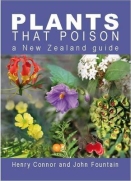Book: Plants that Poison
Plants that Poison: a New Zealand Guide, by Henry Connor and John Fountain.

2009, out of print, but available from the Allan Herbarium.
Our mission: ‘To encourage and improve horticulture in NZ by promoting the understanding, appreciation, conservation and use of plants’.
A list of poisonous plants in New Zealand
The following list is part of a resource published by the Ministry of Health: Nga kupu Oranga Healthy Messages, A health and safety resource for early childhood services, published in 1998. Some of the names have been corrected here.
Links from the plant names are to images and descriptions reproduced with permission from Common Weeds of New Zealand.
| Common Name | Botanical Name | Poisonous Parts |
|---|---|---|
| Apple of Sodom | Solanum
linnaeanum
Hepper & P.-M. Jaeger (syn. S. sodomeum) |
The berries |
| Apricot | Prunus armeniaca L. | The kernels inside the fruit stone. However, they are not poisonous once they have been cooked. |
| Arum | Arum spp. | All parts |
| Bittersweet | Solanum dulcamara L. | All parts, especially the berries |
| Boxthorn | Lycium ferocissimum Miers | Berries |
| Buttercup (Celery-leaved) | Ranunculus sceleratus L. | Leaves and flowers |
| Calico bush | Kalmia latifolia L. | All parts |
| Cape tulip | Moraea flaccida (Sweet) Steud. (was Homeria collina) | All parts are very poisonous, even when they are dead and dry |
| Castor oil plant | Ricinus communis L. | Seeds |
| Daphne | Daphne spp. | All parts |
| Elephant ear | Alocasia brisbanensis (F.M.Bailey) Domin. (was A. macrorrhizos) | Flowers, leaves and stems |
| English yew | Taxus baccata L. | The brown seed inside each berry |
| Foxglove | Digitalis purpurea L. | Leaves and seeds |
| Hemlock | Conium maculatum L. | All parts are very poisonous, even when they are dead and dry |
| Henbane | Hyoscyamus niger L. | Seed and fruit |
| Holly | Ilex aquifolium L. | Berries |
| Horse chestnut | Aesculus hippocastanum L. | Seeds |
| Inkweed | Phytolacca octandra L. | Berries, leaves and root |
| Ivy | Hedera helix L. | The fruit. People with sensitive skins may also develop a rash after touching the plant. |
| Ivy, Poison | Toxicodendron radicans Kuntze (syn. Rhus radicans) | The climbing plant is very poisonous when touched. The shrub may also cause a rash and swelling if it is touched by people with sensitive skin. Note: absent from New Zealand. |
| Jerusalem Cherry | Solanum pseudocapsicum L. | All parts, particularly the berries |
| Karaka | Corynocarpus laevigatus J.R.Forst. & G.Forst. | The kernels of the fruit |
| Kowhai | Sophora microphylla Aiton | All parts, but mainly the seeds |
| Laburnum | Laburnum anagyroides Medik. | All parts, especially the seeds |
| Lantana | Lantana carmara L. | The fruit |
| Lily-of-the-Valley | Convallaria majalis L. | All parts, especially the seeds |
| Milkweed | Euphorbia peplus L. | The fruit and leaves |
| Ngaio | Myoporum laetum G.Forst. | The fruit, leaves and any other green parts |
| Nightshade, Black | Solanum nigrum L. | The leaves and green berries |
| Nightshade, Deadly | Atropa bella-donna L. | All parts are very poisonous |
| Oleander | Nerium oleander L. | All parts, especially the leaves and flowers |
| Onga-onga or Tree Nettle | Urtica ferox G.Forst. | The fine white stinging hairs are violently poisonous and can cause death if you are badly stung |
| Peach | Prunus persica (L.) Batsch | The raw pip that is found inside the fruit stone |
| Poppy (includes Iceland, Shirley and Oriental poppies) |
Papaver spp. | The unripe seeds |
| Poroporo | Solanum aviculare G.Forst. | The leaves and green berries |
| Potato | Solanum tuberosum L. | Green potatoes and the berries |
| Privet | Ligustrum vulgare L. | The leaves and fruit |
| Queen of the Night | Cestrum nocturnum L. | All parts |
| Rangiora | Brachyglottis repanda J.R.Forst. & G.Forst. | All parts, especially the flowers and sap |
| Rhododendron | Rhododendron spp. | All parts |
| Spindle Tree | Euonymus europaeus L. | The fruit and leaves |
| Thornapple or Jimsons Weed | Datura stramonium L. | All parts, especially the leaves, seeds and nectar on the flowers |
| Tutu | Coriaria spp. | All parts, except the soft, black petals |
| White Cedar | Melia azedarach L. | The fruit |